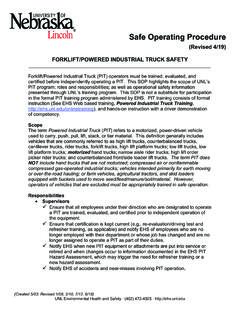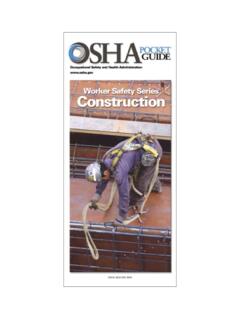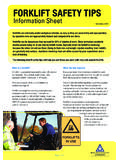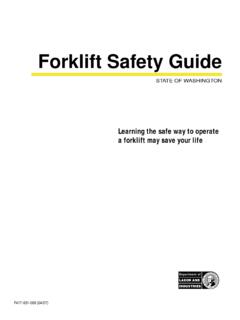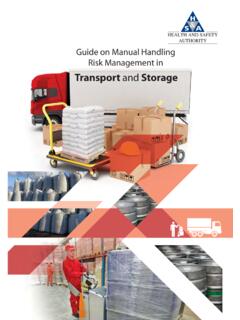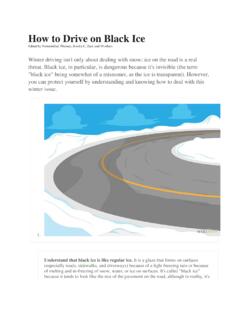Transcription of Safe Use of Ladders and Stepladders
1 SAFE USE OF Ladders AND STEPLADDERS11 Safe Use of Ladders and Stepladders A brief guideGuidance Document LA455 Produced by the Ladder Association in co-operation with the USE OF Ladders AND STEPLADDERS2 Foreword from the HSEI ntroductionWhen is a ladder the most suitable equipment?Who can use a ladder at work?Check your ladder before you use itUsing your ladder safelyWhat about the place of work where the ladder will be used?What are the options for securing Ladders ?What about Ladders used for access?What about the condition of the equipment?Further readingTABLE OF CONTENTSPage1122349910101101020304050607 08091011 SAFE USE OF Ladders AND STEPLADDERSSAFE USE OF Ladders AND STEPLADDERS12 This guidance is for employers on the simple, sensible precautions they should take to keep people safe when using portable leaning Ladders and Stepladders in the workplace. It will also be useful for employees and their this guidance helps you to comply with health and safety law, but you are free to take other law calls for a sensible, proportionate approach to managing risk.
2 Further guidance on how to decide whether a ladder is the right type of equipment for a particular task is also provided in Working at height: A brief guide (see Further reading).References to Ladders in this leaflet, unless otherwise indicated, are to types of portable leaning Ladders and Stepladders , and the guidance applies to both. More specific requirements that apply only to a certain type of ladder are covered in detail under the relevant and Stepladders are not banned under health and safety fact they can be a sensible and practical option for low-risk, short-duration tasks, although they should not automatically be your first choice. Make sure that you use the right type of ladder and that you know how to use it from the HSEF alls when working at height remain the most common kind of workplace fatality, accounting for around a quarter of all worker deaths and 8% of all non-fatal injuries every year, with many involving a fall off a ladder.
3 It s essential that people use the right type of ladder for a task and know how to use it work in close partnership with the Ladder Association, and we are pleased to offer our support for this publication. Written by industry experts, this guide helps people better understand how to manage work at height risks and complements more detailed information freely available from the Ladder want to help people better understand how to manage work at height risk, to reduce harm and for everyone to go home safely every day. Peter BrownDirectorHSE Engagement and PolicySAFE USE OF Ladders AND STEPLADDERS2To use a ladder, you must be competent or, if you are being trained, you should be working under the supervision of a competent can be demonstrated through a combination of training, practical and theoretical knowledge, and experience. Training should be appropriate for the task, and this includes knowing: how to assess the risks of using a ladder for a particular task; when it is right to use a ladder (and when it is not); which type of ladder to use and how to use duration is not the deciding factor in establishing whether use of a ladder is acceptable you must have first considered risk.
4 As a guide, if your task would require staying up a leaning ladder or stepladder for more than 30 minutes at a time, it is recommended you use alternative should only use Ladders in situations where they can be used safely , eg where the ladder will be level and stable, and can be secured (where it is reasonably practicable to do so).03 When is a ladder the most suitable equipment?The law says that Ladders can be used for work at height when an assessment of the risk for carrying out a task has shown that using equipment offering a higher level of fall protection is not justified because of the low risk and short duration of use, or there are existing workplace features which cannot be can use a ladder at work?Low-riskShort duration&SAFE USE OF Ladders AND STEPLADDERS3205 Check your ladder before you use itBefore starting a task, you should have access to user instructions from the manufacturer in case you need to refer to them.
5 You should always carry out a pre-use check to spot any obvious visual defects to make sure the ladder is safe to pre-use check should be carried out: by the user; at the beginning of the working day; after something has changed, eg a ladder has been dropped or moved from a dirty area to a clean area (check the state or condition of the feet).The check should include: the stiles make sure they are not bent or damaged, as the ladder could buckle or collapse; the feet if they are missing, worn or damaged the ladder could slip. Also check the ladder feet when moving from soft/dirty ground (eg dug soil, loose sand/stone, a dirty workshop) to a smooth, solid surface (eg paving slabs), to make sure the actual feet and not the dirt (eg soil, chippings or embedded stones) are making contact with the ground; the rungs if they are bent, worn, missing or loose, the ladder could fail; the locking mechanism does the mechanism work properly?
6 Are components or fixings bent, worn or damaged? If so, the ladder could collapse. Ensure any locking bars are fully engaged; the stepladder platform if it is split or buckled, the ladder could become unstable or collapse; the steps or treads on Stepladders if they are contaminated, they could be slippery; if the fixings are loose on the steps, they could you spot any of the above defects, do not use the ladder and notify your USE OF Ladders AND STEPLADDERS4 Figure 1 Ladder showing the correct 1 in 4 angle06 Using your ladder safelyOnce you have done your pre-use check, the following simple precautions can minimise the risk of a laddersWhen using a leaning ladder to carry out a task: only carry light materials and tools read the manufacturer s labels on the ladder and assess the risks; don t overreach make sure your belt buckle (or navel) stays within the stiles; make sure the ladder is long enough or high enough for the task.
7 Don t overload the ladder consider your weight and the equipment or materials you are carrying before working at height; check the pictogram or label on the ladder for any advisory information; make sure the ladder angle is at 75 you should use the 1-in-4 rule (ie one unit out for every four units up see Figure 1). always grip the ladder and face the ladder rungs while climbing or descending don t slide down the stiles; don t try to move or extend the ladder while standing on the rungs; don t work off the top three rungs, and try to make sure that the ladder extends at least 1 m (three rungs) above where you are working; don t stand Ladders on movable objects, such as pallets, bricks, lift trucks, tower scaffolds, excavator buckets, vans or mobile elevating work platforms; avoid holding items when climbing (consider using a tool belt); don t work within 6 m horizontally of any overhead power line, unless it has been made dead or it is protected with insulation.
8 Use a non-conductive ladder (eg fibreglass or timber) for any electrical work;SAFE USE OF Ladders AND STEPLADDERS54 maintain three points of contact when climbing and wherever possible at the work position see Figures 2 and 2 Correct user maintaining three points of contactFigure 3 Incorrect overreaching and not maintaining three points of contact where you cannot maintain a handhold, other than for a brief period (eg to hold a nail while starting to knock it in, start a screw etc), you will need to take other measures to prevent a fall or mitigate the consequences if one happened; secure the ladder (eg by tying the ladder to prevent it from slipping either outwards or sideways) and have a strong upper resting point (ie do not rest it against weak upper surfaces such as glazing or plastic gutters see Figure 4); consider using an effective stability device (a device which, if used correctly, prevents the ladder from slipping).
9 Figure 4 Correct use of a stand-off device to ensure a strong resting point. Do not rest a ladder against weak upper surfaces such as glazing or plastic gutters. Follow the manufacturer s USE OF Ladders AND STEPLADDERS6 Telescopic laddersTelescopic Ladders are a variation of leaning Ladders but remember that they don t all work in the same way and some may be more prone to twisting and flexing. They should always be used, stored and transported with care and kept clean. In addition to following this guidance, it s important you read and follow the user instructions provided by the every use in addition to the normal ladder checks make sure they are operating correctly and that the mechanisms that lock each section are working follow the user instructions regarding the opening and closing procedure. Be aware of the potential for trapping fingers between the closing sections.
10 Remember some of the important parts are inside where they cannot be seen. If you are in any doubt, do not use 6 Take care when closing telescopic Ladders not to trap fingersFigure 5 Check all sections are locked before using the ladderSAFE USE OF Ladders AND STEPLADDERS76 StepladdersWhen using a stepladder to carry out a task: Check all four stepladder feet are in contact with the ground and the steps are level; Only carry light materials and tools; Don t overreach; Don t stand and work on the top three steps (including a step forming the very top of the stepladder) unless there is a suitable handhold; Ensure any locking devices are engaged; Try to position the stepladder to face the work activity and not side on. However, there are occasions when a risk assessment may show it is safer to work side on, eg in a retail stock room when you can t engage the stepladder locks to work face on because of space restraints in narrow aisles, but you can fully lock it to work side on; Try to avoid work that imposes a side loading, such as side-on drilling through solid materials (eg bricks or concrete); Where side loadings cannot be avoided, you should prevent the steps from tipping over, eg by tying the steps.
